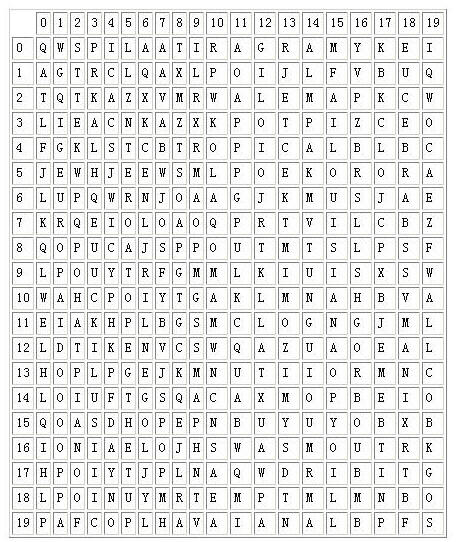POJ 1204 Word Puzzles (AC自動機)
來源:程序員人生 發(fā)布時間:2015-04-11 09:46:24 閱讀次數(shù):3001次
Word Puzzles
| Time Limit: 5000MS |
|
Memory Limit: 65536K |
| Total Submissions: 9926 |
|
Accepted: 3711 |
|
Special Judge |
Description
Word puzzles are usually simple and very entertaining for all ages. They are so entertaining that Pizza-Hut company started using table covers with word puzzles printed on them, possibly with the intent to minimise their client's
perception of any possible delay in bringing them their order.
Even though word puzzles may be entertaining to solve by hand, they may become boring when they get very large. Computers do not yet get bored in solving tasks, therefore we thought you could devise a program to speedup (hopefully!) solution finding in such
puzzles.
The following figure illustrates the PizzaHut puzzle. The names of the pizzas to be found in the puzzle are: MARGARITA, ALEMA, BARBECUE, TROPICAL, SUPREMA, LOUISIANA, CHEESEHAM, EUROPA, HAVAIANA, CAMPONESA.

Your task is to produce a program that given the word puzzle and words to be found in the puzzle, determines, for each word, the position of the first letter and its orientation in the puzzle.
You can assume that the left upper corner of the puzzle is the origin, (0,0). Furthemore, the orientation of the word is marked clockwise starting with letter A for north (note: there are 8 possible directions in total).
Input
The first line of input consists of three positive numbers, the number of lines, 0 < L <= 1000, the number of columns, 0 < C <= 1000, and the number of words to be found, 0 < W <= 1000. The following L input lines, each one of
size C characters, contain the word puzzle. Then at last the W words are input one per line.
Output
Your program should output, for each word (using the same order as the words were input) a triplet defining the coordinates, line and column, where the first letter of the word appears, followed by a letter indicating the orientation
of the word according to the rules define above. Each value in the triplet must be separated by one space only.
Sample Input
20 20 10
QWSPILAATIRAGRAMYKEI
AGTRCLQAXLPOIJLFVBUQ
TQTKAZXVMRWALEMAPKCW
LIEACNKAZXKPOTPIZCEO
FGKLSTCBTROPICALBLBC
JEWHJEEWSMLPOEKORORA
LUPQWRNJOAAGJKMUSJAE
KRQEIOLOAOQPRTVILCBZ
QOPUCAJSPPOUTMTSLPSF
LPOUYTRFGMMLKIUISXSW
WAHCPOIYTGAKLMNAHBVA
EIAKHPLBGSMCLOGNGJML
LDTIKENVCSWQAZUAOEAL
HOPLPGEJKMNUTIIORMNC
LOIUFTGSQACAXMOPBEIO
QOASDHOPEPNBUYUYOBXB
IONIAELOJHSWASMOUTRK
HPOIYTJPLNAQWDRIBITG
LPOINUYMRTEMPTMLMNBO
PAFCOPLHAVAIANALBPFS
MARGARITA
ALEMA
BARBECUE
TROPICAL
SUPREMA
LOUISIANA
CHEESEHAM
EUROPA
HAVAIANA
CAMPONESA
Sample Output
0 15 G
2 11 C
7 18 A
4 8 C
16 13 B
4 15 E
10 3 D
5 1 E
19 7 C
11 11 H
Source
Southwestern Europe 2002
題目鏈接:http://poj.org/problem?id=1204
題目大意:給1個字符矩陣,和1些單詞,求這些單詞的首字母的位置和單詞的方向,1共8個方向,正北為A,順時針BCD...
題目分析:對單詞建立trie樹,構(gòu)造ac自動機,以4個邊上的字符為出發(fā)點向8個方向枚舉找
#include <cstdio>
#include <cstring>
#include <queue>
#include <algorithm>
using namespace std;
int const MAX = 1005;
char map[MAX][MAX], s[MAX];
int r, c, n;
int len[MAX], ans[MAX][3];
int dx[8] = {⑴, ⑴, 0, 1, 1, 1, 0, ⑴};
int dy[8] = {0, 1, 1, 1, 0, ⑴, ⑴, ⑴};
struct node
{
int id;
node *next[26];
node *fail;
node()
{
id = ⑴;
memset(next, NULL, sizeof(next));
fail = NULL;
}
};
void Insert(node *p, char *s, int id)
{
for(int i = 0; s[i] != '
主站蜘蛛池模板:
国产精品久久久久一区二区三区
|
麻豆久久精品免费看国产
|
亚洲免费视频播放
|
一级欧美毛片成人
|
韩国女主播一区二区三区视频
|
琪琪五月天
|
天堂最新版在线www在线
|
亚洲欧美国产一区二区三区
|
色人阁在线
|
久久精品亚洲99一区二区
|
国产片免费
|
日韩精品一区在线观看
|
欧美日韩高清观看一区二区
|
亚州精品一区二区三区
|
欧美一区二区三区成人看不卡
|
网友自拍区一区二区三区
|
在线成人免费视频
|
欧美黑人激情乱妇
|
国产大学生露脸激情
|
国产成人午夜性a一级毛片
国产成人系列
|
亚洲一区二区三区四区视频
|
香蕉高清免费永久在线视频
|
日本高清精品动漫
|
日本叼嘿
|
亚洲精品一二三区
|
91久久偷偷做嫩草影院免费看
|
亚洲成a人片在线观看中文动漫
|
亚洲国产精品一区二区三区在线观看
|
亚洲欧美综合另类
|
黑人性受xxxx黑人xyx性爽
|
成人免费体验区福利云点播
|
另类小说综合
|
国产成人精品亚洲午夜麻豆
|
日日夜夜精品免费视频
|
久久精品亚洲综合
|
日本 欧美 在线
|
欧美日韩一区二区三区视视频
|
中文字幕资源在线
|
亚洲国产精品久久久久久
|
一级a毛片免费观看
|
99精品国产美女福到在线不卡
|
